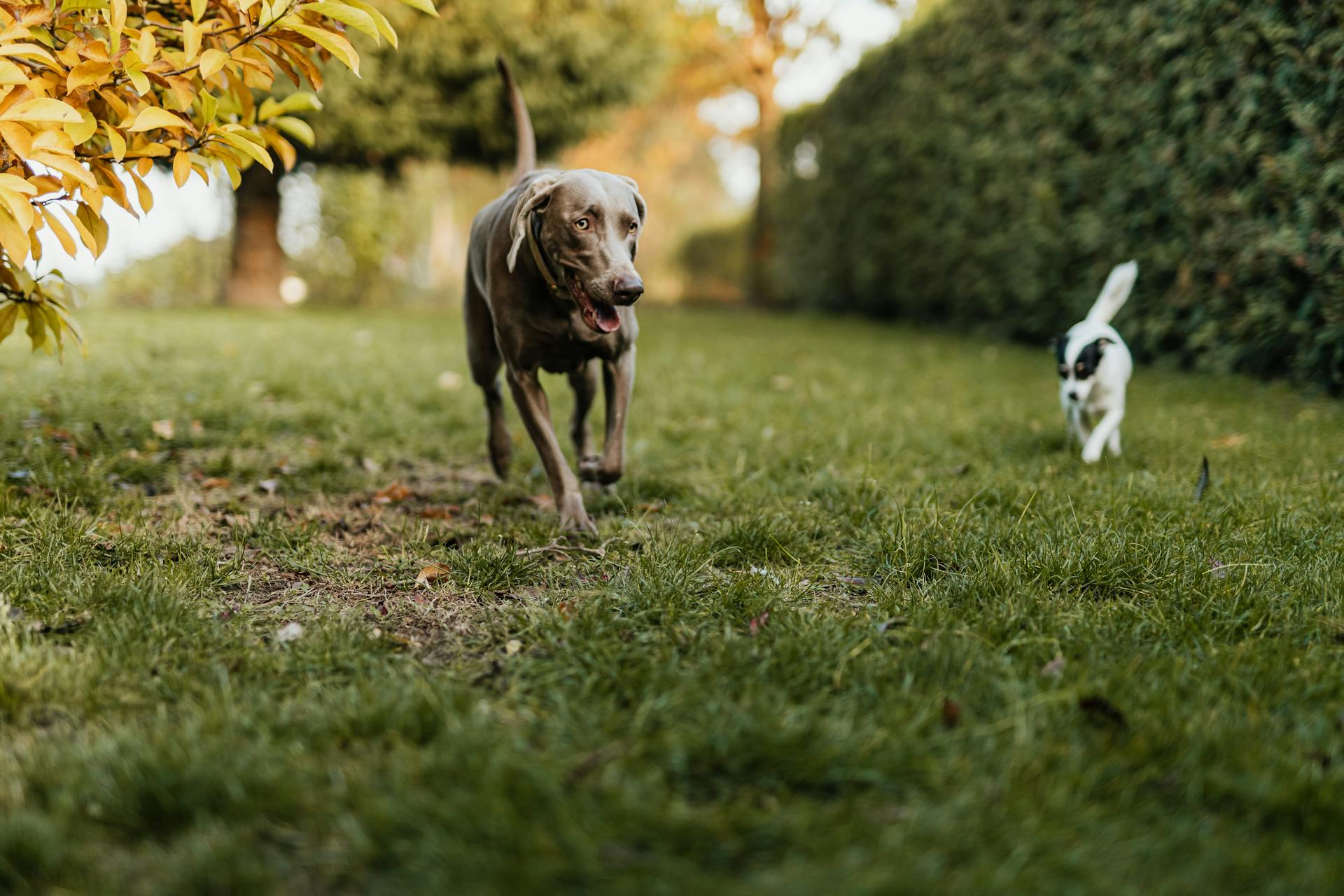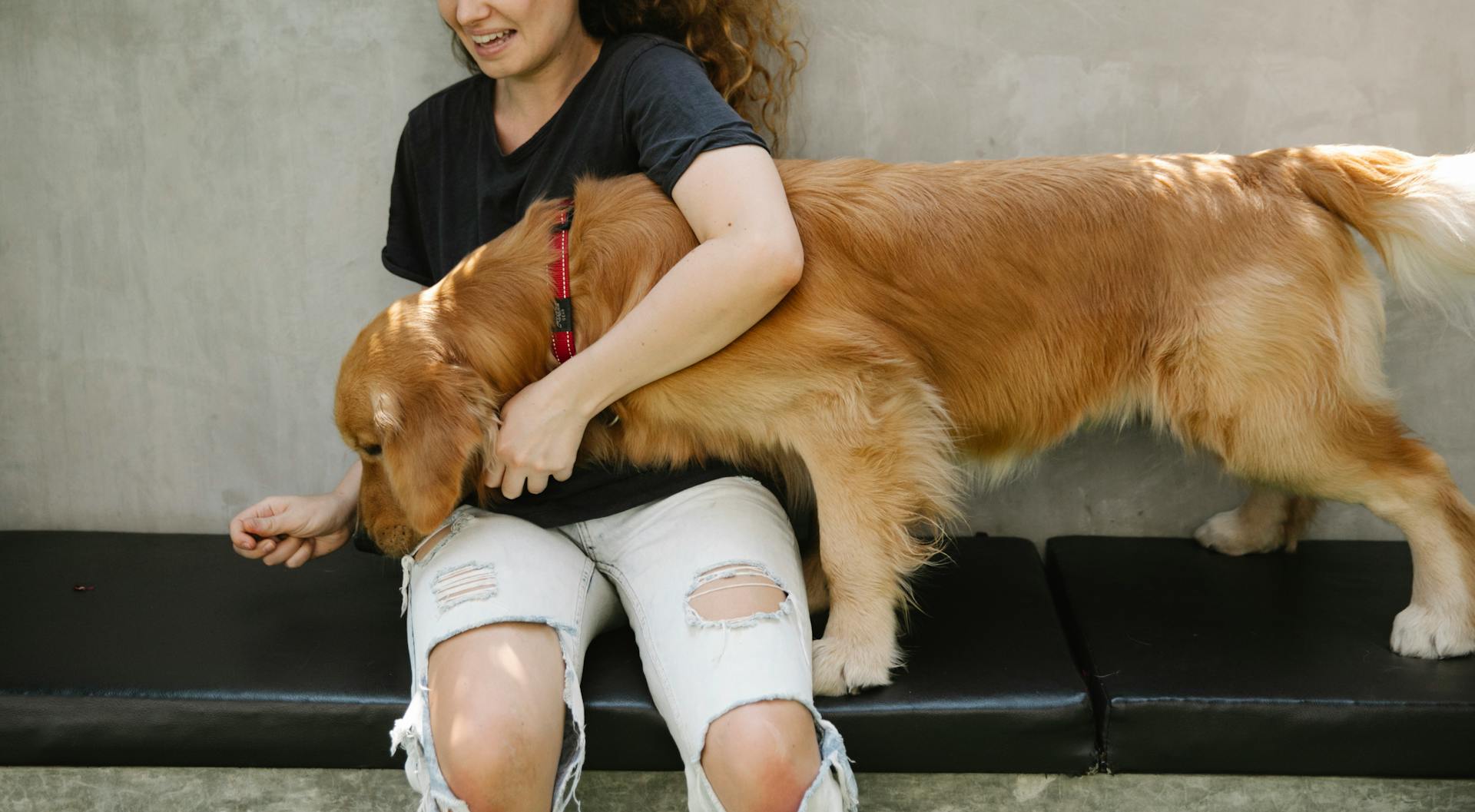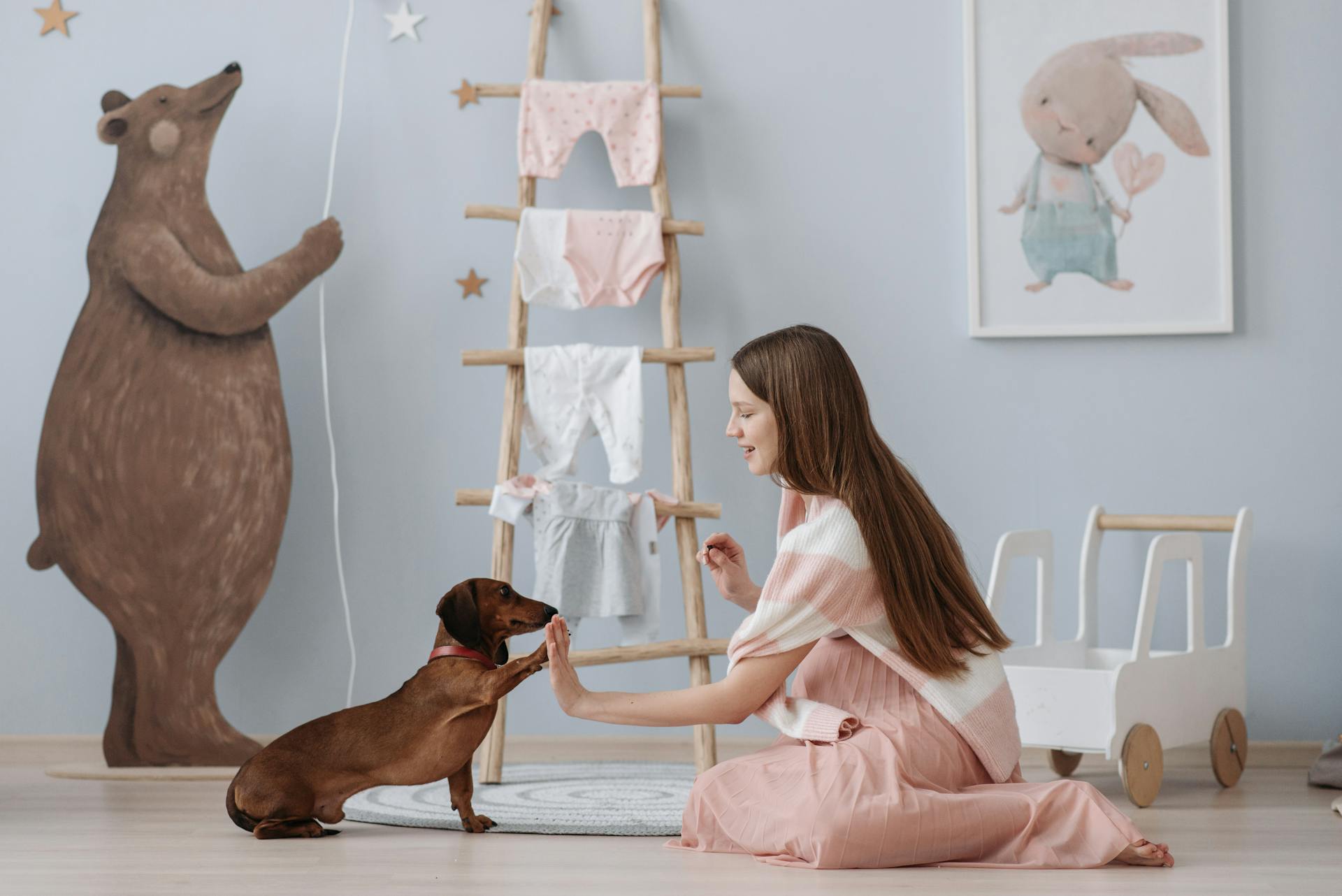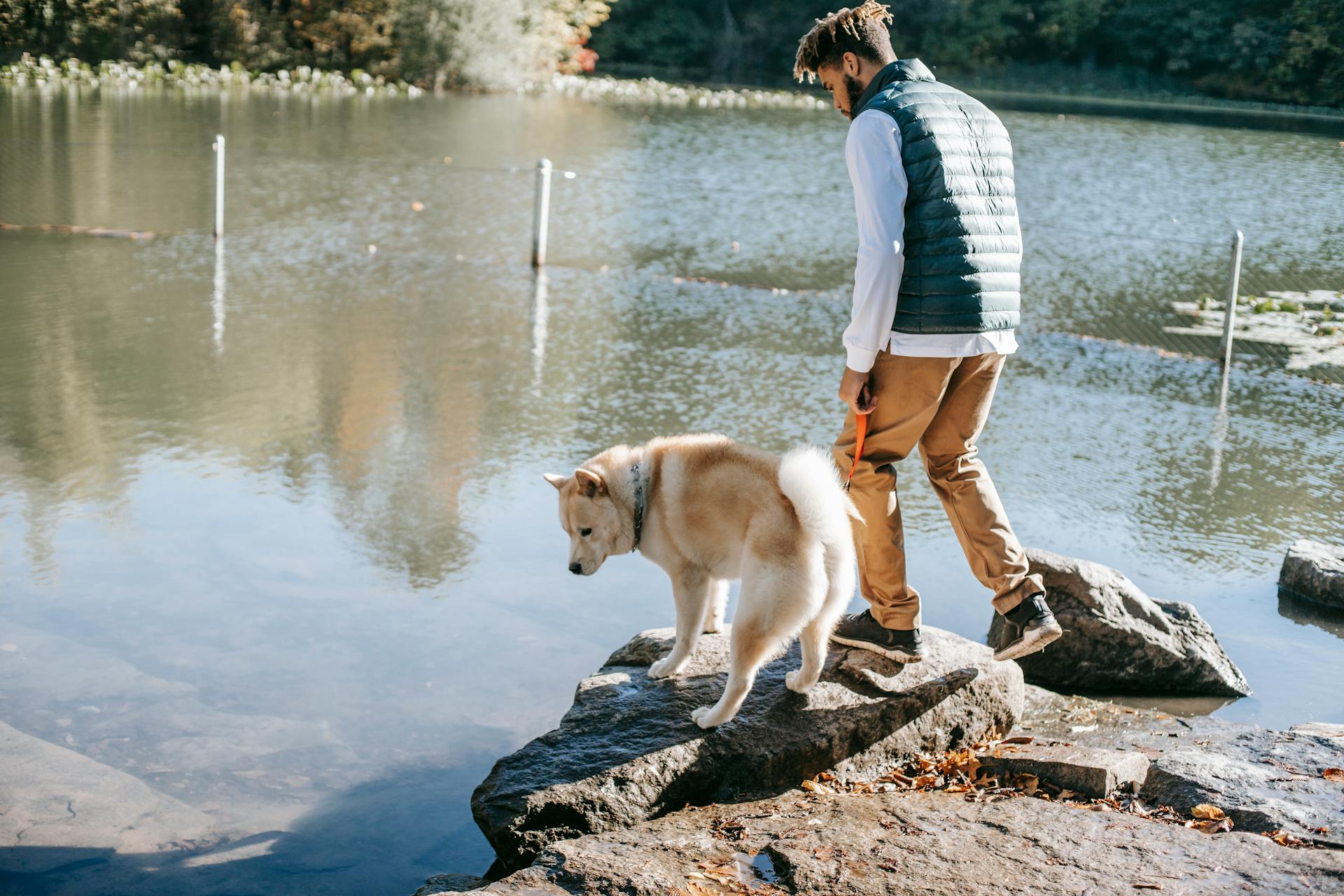
Disciplining a dog for peeing indoors can be frustrating, but it's essential to approach the situation calmly and consistently. A good place to start is by identifying the underlying causes of the behavior, such as medical issues or lack of potty training.
First, take your dog to the vet to rule out any underlying medical issues that might be causing the problem. Some dogs may have medical conditions that make it difficult for them to hold their urine.
Consistency is key when it comes to potty training a dog. Establish a regular routine for feeding, exercise, and potty breaks to help your dog learn when it's time to go outside.
Accidents will happen, but it's essential to clean up accidents thoroughly with a pet-safe cleaner to remove any remaining scent that might attract your dog to the same spot again.
Related reading: When to Stop Crate Training
Determining the Cause of House-Soiling
To determine the cause of house-soiling, a physical examination and medical history are first required. This is crucial to rule out any underlying medical issues that may be contributing to the problem.
Most cases of house-soiling require a urinalysis and general blood profile. This will help identify any potential medical problems that need to be addressed.
Additional tests such as radiographs and contrast studies may be necessary if there are any abnormalities in elimination frequency or amount. This will help pinpoint the cause of the problem.
If medical problems have been ruled out, it's essential to consider whether your dog was ever completely house-trained. If not, it may be more challenging to address the issue.
Changes in the pet's household or schedule at the time the problem started should also be taken into account. This could be a contributing factor to the house-soiling.
It's also important to consider whether your dog is marking or eliminating on horizontal surfaces. This can be a sign of anxiety or other underlying issues.
Some dogs may exhibit anxiety when their owners leave or when they are locked in their confinement area. This can lead to house-soiling.
Submissive or excitement urination can also be a cause of house-soiling.
For more insights, see: When Do Male Dogs Start Lifting Their Leg to Pee
Prevention and Training
Patience is key when it comes to potty training your dog. You must be patient and persevere to make the process comfortable and effective for both you and your pet.
Demanding too much from your dog can lead to regression, so it's essential to take a step-by-step approach. Rewarding your dog for good behavior is crucial, and giving them more time is often necessary.
If your dog has learned to urinate outside but suddenly starts having accidents in the house, it could be a sign of a medical condition, so it's always a good idea to visit your vet first.
If this caught your attention, see: Female Dog Urinating a Lot
Feeding Schedules
Feeding Schedules can be a game-changer for dog owners. By regulating your dog's eating schedule, you can improve your control over the situation.
Dogs that eat free-choice often need to relieve themselves at a variety of times throughout the day. This can make potty training and housebreaking more challenging.
On the other hand, dogs that eat one or two scheduled meals each day tend to void in a more predictable manner. This makes it easier to establish a consistent potty routine.
Feeding a low-residue diet may also be beneficial, as it can reduce your dog's urgency to defecate and produce fewer stools. This can lead to fewer accidents and a cleaner home.
Readers also liked: Why Is My Dog's Pee Greasy?
Poor Training

Poor Training can be a frustrating experience for both dog owners and their pets.
Demanding too much from your dog and moving too quickly through the training process can lead to anger and regression in your dog.
Patience and perseverance are key to making home training comfortable and effective for your pet.
If your dog is still a puppy and urinating inappropriately, it's likely they're not completely potty trained yet.
Rewarding your dog for good toilet behavior and giving them more time will help you reach your goal.
If your dog has suddenly started urinating inappropriately after being well-trained, it could be a sign of a medical condition or stress.
Visiting your vet to rule out any health issues is essential in these cases.
Addressing Accidents
Punishment only increases your dog's anxiety and may cause them to hide when they need to go to the bathroom, thereby decreasing their ability to give you a cue when they need to go outside.
Intriguing read: Alternative Food for Dogs
If your dog has been marking for a long time, a pattern may already be established, making it more challenging to address the issue.
Clean soiled areas thoroughly with a cleaner specifically designed to eliminate urine odor.
Make previously soiled areas inaccessible or unattractive by placing items that might cause marking out of reach, such as guests' belongings and new purchases in a closet or cabinet.
To prevent future accidents, keep an eye on your dog when they're indoors for signs that they're thinking about urinating and calmly take them outside.
If your dog is marking out of anxiety, talk to your vet about whether medications may be appropriate.
To help your dog associate certain areas with positive experiences, feed, treat, and play with them in the areas where they mark.
Here are some additional tips to help you address accidents:
- Resolve conflicts between animals in your home, such as a new cat or dog, by following our tip sheets to help them live in harmony.
- Make friends with your pet by having the new resident make friends with your pet by feeding and playing with your pet.
- Consider tethering your dog to you with a leash when you're distracted, like when cooking dinner, to monitor them for signs they need to urinate.
- Consult an animal behaviorist for help with resolving the marking issues.
House-Soiling Treatment
House-soiling treatment requires patience and consistency. Training techniques for house-soiling dogs are virtually identical to those needed to house train a new puppy.
To address the underlying issue, it's essential to understand that dogs that eliminate indoors are performing a self-rewarding behavior. They relieve themselves and don't perceive the area as inappropriate.
Retraining your dog to eliminate outdoors can be challenging, but it's not impossible. Even if your dog is retrained to go outside, they may still be attracted to indoor sites due to the odor, substrate, and learned habit.
To prevent this, thoroughly clean up any indoor accidents with a cleaner specifically designed to eliminate urine odor. Enzyme cleaners are a good option for this purpose.
Here are some additional tips to help you treat house-soiling:
- Closely supervise your dog during retraining.
- Confining your dog to a crate or bedroom area when you can't supervise can be helpful.
- Make previously soiled areas inaccessible or unattractive.
- Feed, treat, and play with your dog in areas where they mark.
- Resolve conflicts between animals in your home.
- Make friends with your dog to reduce anxiety.
- Consult an animal behaviorist if needed.
Health Problems
Health problems can be a major reason why your dog is peeing in the house. A range of conditions can be responsible for causing your dog to involuntarily lose control of the muscles in their bladder.
A bladder infection or urinary tract infection can cause your dog to pee in the house. Intestinal parasites, diabetes, kidney or liver problems, and tumors can also be to blame.
If your dog is old or has age-related conditions, they may not be able to hold it for long. In this case, you may need to consider more frequent trips outside or set up an area with training pads for emergencies.
Some common health issues that can cause house-soiling include bladder stones, cognitive issues like dementia, and old age. These conditions can be serious, so it's essential to rule them out with a visit to your veterinarian.
If your dog has a chronic disease, such as kidney disease, and you notice blood in their urine, you need to see a vet immediately. This is no time to waste, as it could be a sign of a more serious health issue.
Here are some potential health problems that can cause house-soiling:
- A bladder infection or urinary tract infection
- Bladder stones
- Intestinal parasites
- Diabetes
- Kidney or liver problems
- Tumors
- Old age and age-related conditions
- Cognitive issues like dementia
Monitoring your dog's behavior and watching for signs of health conditions can help you catch any problems early on. A pet camera like the Petcube Cam 360 can be a useful tool in this regard, allowing you to keep an eye on your dog from anywhere.
House-Soiling Treatment
House-Soiling Treatment is a process that requires patience, consistency, and understanding of your dog's behavior. It's essential to determine the underlying cause of the problem, which may involve medical issues, changes in the household, or anxiety.
A physical examination and medical history are the first steps in diagnosing the cause of house-soiling. Additional tests such as urinalysis, radiographs, and contrast studies may be necessary to rule out any medical problems.
Training techniques for house-soiling dogs are similar to those used for house-training a new puppy. However, retraining may not be enough to eliminate indoor sites, as the odour, substrate, and learned habit may continue to attract your dog.
Dogs that eliminate indoors often do so because they perceive it as a self-rewarding behavior. To address this, you need to provide an alternative, outdoor location for your dog to eliminate.
A thorough clean-up of indoor accidents is crucial to prevent your dog from returning to the same spot. Use enzyme cleaners to eliminate lingering smells that your dog can detect but you can't.
Here's an interesting read: Indoor Dog House Training
Spaying or neutering your dog can reduce urine-marking, but it may not eliminate the problem entirely if it's a learned behavior. In such cases, use techniques for housetraining an adult dog to modify your dog's marking behavior.
Here are some practical tips to help you address urine-marking:
- Clean soiled areas thoroughly with a cleaner specifically designed to eliminate urine odor.
- Make previously soiled areas inaccessible or unattractive.
- Keep objects likely to cause marking out of reach.
- Resolve conflicts between animals in your home.
- Make friends with your pet by feeding and playing with them in areas where they mark.
- Watch your dog for signs of anxiety and consult your vet about medications if necessary.
- Consult an animal behaviorist for help with resolving marking issues.
By following these steps and tips, you can help your dog overcome house-soiling and marking behaviors.
Managing Triggers
Identifying triggers is a crucial step in addressing housebreaking issues. Common triggers include changes in your work schedule, travel, or even the arrival of a new family member.
To minimize the impact of triggers, establish a consistent routine for feeding, exercise, and potty breaks. This will help your dog feel more secure and in control.
For example, if you notice your dog pees in the house after a change in your work schedule, try to adjust your feeding and exercise routine to maintain a sense of normalcy.
Related reading: How Do Dog Pee Pads Work
Stress
Stress can be a major trigger for dogs to pee indoors, especially if they're experiencing anxiety due to changes in their environment.

A sudden or dramatic change in your dog's life can cause anxiety, leading to incontinence. This could be a recent move, a new family member, or a change in your daily routine.
Loud unfamiliar noises, like a new appliance or thunderstorms, can also be a source of stress for your dog. They may be frightened by something outdoors and unable to go outside.
If your dog is feeling anxious because they miss you while you're away, products like the Petcube Bites 2 Lite can be helpful. This camera allows you to interact with your dog remotely and even dispense treats to keep them stimulated.
Excitement or Submission
Excitement or submission can be a trigger for your dog to pee indoors. Sometimes a dog will be unable to control their bladder when they're extremely excited or when they feel vulnerable or intimidated.
Dogs that uncontrollably pee out of excitement to see you are examples of this behavior. Puppies commonly get overexcited and lose bladder control, but they most often grow out of this.
Dogs that cower in fear and lose control of their bladder are also examples of this. It isn’t uncommon for some dogs to carry this behavior into adulthood.
Surveillance
Surveillance is key to preventing accidents and reinforcing good behavior in your dog. You need to keep a close eye on your dog at all times to catch the signs that they're getting ready to pee.
A dog that's looking for a place to potty will circle and sniff and whine, and they'll almost always return to the scene of previous toilet mishaps. This is a clear indication that they need to go outside.
Supervising your dog is crucial, especially in the early stages of house training. You can't rely on your dog to remember to go outside, so it's up to you to keep them on track.
You can prevent accidents by redirecting your dog to an appropriate area when you catch them in the act of eliminating in an inappropriate location. If you can't keep an eye on your dog at all times, consider using a remote indoor leash to keep them from getting into trouble.
Intriguing read: Training Dog to Pee outside
Here are some tips for supervising your dog:
- Reinforce acceptable behavior with lavish praise or food rewards when you catch your dog eliminating in an appropriate place.
- Use a word cue prior to each elimination so your dog will learn to eliminate on command.
If you're unable to supervise your dog at all times, make sure they're in a confinement area where they don't have access to indoor elimination sites. This could be a bedroom, crate, or pen, or an area where elimination is allowed, such as a dog run or outdoors.
Frequently Asked Questions
How do I stop my dog from peeing in the house out of spite?
To address your dog's house soiling issue, identify and address any underlying triggers, such as medical issues or separation anxiety, by increasing potty breaks, confining your dog when you're not home, and considering spaying or neutering. By taking these steps, you can help your dog learn to eliminate outside and reduce unwanted accidents.
Sources
- https://www.vetwest.com.au/pet-library/house-soiling-elimination-and-marking-problems-in-dogs/
- https://peachonaleash.com/housetraining-a-dog-that-refuses-to-potty-outside/
- https://www.humanesociety.org/resources/how-stop-your-dog-peeing-unwanted-spots
- https://www.askthedogguy.com/peeing-in-the-house-training/
- https://petcube.com/blog/why-do-dogs-pee-in-the-house/
Featured Images: pexels.com


